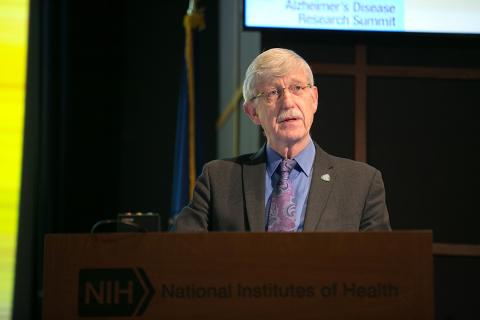Alzheimer’s Summit Features Research Advances, Recommendations

More than 3,000 participants from government, academia, industry, nonprofit organizations and the public recently convened on campus and online to discuss how much has been accomplished and what is needed to enable precision medicine research for Alzheimer’s and meet the research goal of the National Plan to Address Alzheimer’s Disease—to treat and prevent it by 2025.
The NIH Alzheimer’s Disease Research Summit 2018: Path to Treatment and Prevention led to a series of recommendations designed to guide efforts to build a collaborative, multi-stakeholder research environment capable of delivering urgently needed cures for people at all stages of the disease.
As many as 5.5 million older Americans live with AD, and the number is expected to climb to nearly 14 million by 2050 unless ways to delay, treat or prevent it are discovered. Millions more have other types of dementia or serve as caregivers.
“Alzheimer’s disease is a worthy and complex foe,” said NIH director Dr. Francis Collins, who welcomed summit participants. “Yet science’s armament is growing daily, and we know so much more.”
NIA director Dr. Richard Hodes noted advances in recent years, including increased federal funding for Alzheimer’s research that has enabled more opportunities for a wide range of study.
Since the last summits held in 2012 and 2015, NIH has helped launch public-private partnerships that have advanced and integrated discoveries in basic, translational and clinical research using open-science platforms for data sharing. Hodes mentioned, for example, the Accelerating Medicines Partnership-Alzheimer’s Disease, which has identified more than 100 novel candidate targets for drug discovery.
“Those potential targets can be prioritized and moved forward through clinical validation and, hopefully, some of them will make it to the next generation of clinical interventions,” he said. Currently, there are treatments for Alzheimer’s symptoms but nothing that changes the course of the underlying brain disease.
The emerging picture of Alzheimer’s is of a disease that is complex and heterogeneous, with many possible causes at different stages of the disease, Hodes said. Scientists are learning more about how many different proteins, metabolites and other molecular players act and interact—with each other and with certain genetic variants—to influence the onset and progression of Alzheimer’s. biological drivers of Alzheimer’s disease. These studies have also helped identify new brain regions to study. Similarly, big data has enabled large-scale genomic studies that have identified many more risk factor genes associated with Alzheimer’s.
Speakers at the summit emphasized the importance of public datasets and partnerships that facilitate data sharing and collaboration.
“We are trying to make the open science and open source ethos the norm in Alzheimer’s research,” said Dr. Suzana Petanceska, a program officer for NIA’s Division of Neuroscience and one of the lead organizers of the event. “The good news is that funding organizations and publishers are beginning to come together and align incentives to maximize the sharing of data and research resources.”
For instance, the Model Organism Development and Evaluation for Late-onset Alzheimer’s Disease consortium, formed in 2016, is designed to deliver up to 50 new rodent models for late onset Alzheimer’s and enable their rapid distribution for use in basic research and therapy development without intellectual property barriers; in addition, the consortium will make the data rapidly available to researchers at-large and establish rigorous methods for testing new candidate therapeutics.
With so many possible influences on AD, from genetic variants to cardiovascular risks, researchers at the summit called for a more individualized understanding of people with or at risk for Alzheimer’s. What causes Alzheimer’s in one person—and what treatments work—may be different than in another person. Progress will require a better understanding of individual differences in biology, lifestyle and environment.
“This is a critical time in Alzheimer’s research, with new opportunities to build upon what we have learned,” said Hodes. “We must continue to foster creative approaches that leverage emerging scientific and technological advances, establish robust translational infrastructure for rapid and broad sharing of data and research tools and work with funding partners and other stakeholders to cultivate and sustain an open science research ecosystem.”
